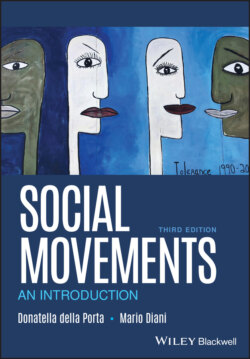Читать книгу Social Movements - Donatella della Porta - Страница 27
2.3.2 Cultures and Countercultures
ОглавлениеGrowing differentiation in lifestyles represents another source of problematization of social identities. In a world in which class allegiances seem fragmented and political ideologies are in crisis, cultural consumption, use of one’s free time, ways of organizing one’s emotional life, eating habits, or styles of clothes can all represent a powerful factor for diversification and, in the final analysis, of new stratification, among social groups (Bourdieu 1984; Eder 1993). In many cases, it is simply an issue of individual consumer behavior, no different from other fashion phenomena. In other cases, however, lifestyle becomes the stake in conflicts regarding the legitimacy of emerging cultural forms or the defense of traditional ones.
Youth movements and other oppositional countercultures provide examples of how individual lifestyle may take up an antagonistic character. The emergence of punk at the end of the 1970s had elements that could easily be reduced to fashion, but also a powerful symbolic antagonism, in the sense of breaking away from consolidated canons of decorum and good taste. In other words, it also had a distinctive countercultural flavor (Crossley 2015). Similar remarks may apply to other forms of youth cultural experience, from rap to rave. More recently, alternative cultures and lifestyles have been nurtured in the Italian and Spanish squatted youth centers, as well as in the radical wing of the antiroad movement in the United Kingdom (Doherty 1998; della Porta, Andretta, et al. 2006). In the late twentieth century, various sectors of social movements have indeed reserved considerable space to action concerning consumer goods and cultural elaboration. Women’s, squatters’, or youth movements have promoted the construction of alternative networks offering autonomous opportunities for support and social contacts to their participants (Melucci 1984; Taylor and Whittier 1992; see Chapter 7).
In other cases, collective action on lifestyles has been concerned with the defense of values and traditions which, it was held, were threatened. Movements such as the American Moral Majority or those against the introduction of divorce in Italy in the early years of the 1970s also chose the private sphere and the criteria by which one can define a particular lifestyle as ethically desirable as their favored terrain for political mobilization (Wood and Hughes 1984; Wallis and Bruce 1986; Oberschall 1993, Chapter 13).
The growing importance of lifestyle has also led to consumerism becoming a specific object of collective action. The consumer has been increasingly identified as a political, and not simply as an economic, actor. Consumer organizations have addressed their mobilization attempts to the public in general. Structures for the production and distribution of alternative goods, for example, in the food sector, have been created; campaigns and mobilizations in favor of consumers have also been launched. They have taken forms ranging from quasi‐countercultures (for example, in the alternative networks promoting and distributing organic food in the early stages of environmental movements) to classic public interest‐group action (for example, in the form of mass professional organizations like Common Cause) (Baek 2010; Boström, Micheletti, and Peter Oosterveer 2019; Earl, Copeland, and Bimber 2017; Forno and Graziano 2014). Fair trade and boycotts have grown enormously in recent years, with a particularly successful trend among young people (Micheletti 2003; see also Chapter 7).
Although not always connected with each other, all these activities, from different points of view, draw our attention once again to the new importance assumed by collective action concerned with the defense of certain models of behavior and moral codes, rather than with the conquest of political power or the protection of economic interests. Various transformations in the private sphere and in forms of cultural production appear to have increased potential for conflicts of a symbolic nature. The variety of life experiences to which the individual has access is a result of the multiplication of group allegiances. Each of these can provide relationship and identity resources essential in turning some of the possible sources of inequality into a public debate, defining them as social problems rather than individual difficulties. As Pierre Bourdieu observes, indeed, “Each society, at each moment, elaborates a body of social problems taken to be legitimate, worthy of being debated, of being made public and sometimes officialized and, in a sense, guaranteed by the state” (1992, p. 236).
In parallel, the map of adversaries against which collective energies can, from time to time, be mobilized is equally varied: mass media, technoscientific elites, educational and social welfare institutions, entrepreneurial classes that control mass consumption, and so on. In this situation of uncertainty, instead of representing the preconditions for action concerned with economic or political goals, the definition of collective identity tends to become an autonomous problem, an object of collective action as such (although this may also apply to class conflict: Pizzorno 1978; see also Chapter 4). The same thing can be said about the search for lifestyles and ways of acting that are ethically desirable and appropriate. These needs do not result inevitably in the development of social movements.
